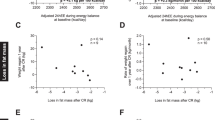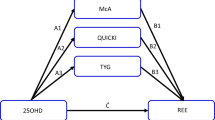Abstract
Background
While recent studies in humans indicate that fat-free mass (FFM) is closely associated with energy intake (EI) when in energy balance, associations between fat mass (FM) and EI are inconsistent.
Objectives
The present study used a cross-sectional design to examine the indirect and direct effects of FFM, FM and resting metabolic rate (RMR) on EI in individuals at or close to energy balance.
Methods
Data for 242 individuals (114 males; 128 females; BMI = 25.7 ± 4.9 kg/m2) were collated from the non-intervention baseline conditions of five studies employing common measures of body composition (air-displacement plethysmography), RMR (indirect calorimetry) and psychometric measures of eating behaviours (Dutch Eating Behaviour Questionnaire). Daily EI (weighed dietary records) and energy expenditure (flex heart rate) were measured for 6–7 days. Sub-analyses were conducted in 71 individuals who had additional measures of body composition (dual-energy X-ray absorptiometry) and fasting glucose, insulin and leptin.
Results
After adjusting for age, sex and study, linear regression and mediation analyses indicated that the effect of FFM on EI was mediated by RMR (P < 0.05). FM also independently predicted EI, with path analysis indicating a positive indirect association (mediated by RMR; P < 0.05), and a stronger direct negative association (P < 0.05). Leptin, insulin and insulin resistance failed to predict EI, but cognitive restraint was a determinant of EI and partially mediated the association between FM and EI (P < 0.05).
Conclusions
While the association between FFM and EI was mediated by RMR, FM influenced EI via two separate and opposing pathways; an indirect ‘excitatory’ effect (again, mediated by RMR), and a stronger direct ‘inhibitory’ effect. Psychological factors such as cognitive restraint remain robust predictors of EI when considered alongside physiological determinants of EI, and indeed, have the potential to play a mediating role in the overall expression of EI.
This is a preview of subscription content, access via your institution
Access options
Subscribe to this journal
Receive 12 print issues and online access
$259.00 per year
only $21.58 per issue
Buy this article
- Purchase on Springer Link
- Instant access to full article PDF
Prices may be subject to local taxes which are calculated during checkout


Similar content being viewed by others
References
Weise C, Hohenadel M, Krakoff J, Votruba S. Body composition and energy expenditure predict ad-libitum food and macronutrient intake in humans. Int J Obes. 2013;38:243–51.
Lissner L, Habicht J-P, Strupp BJ, Levitsky D, Haas JD, Roe D. Body composition and energy intake: do overweight women overeat and underreport? Am J Clin Nutr. 1989;49:320–5.
Hopkins M, Finlayson G, Duarte C, Whybrow S, Horgan GW, Blundell J, et al. Modelling the associations between fat-free mass, resting metabolic rate and energy intake in the context of total energy balance. Int J Obes. 2015;40:312–8.
Piaggi P, Thearle MS, Krakoff J, Votruba SB. Higher daily energy expenditure and respiratory quotient, rather than fat-free mass, independently determine greater ad libitum overeating. J Clin Endocrinol Metab. 2015;100:2015-164.
Caudwell P, Finlayson G, Gibbons C, Hopkins M, King N, Naslund E, et al. Resting metabolic rate is associated with hunger, self-determined meal size, and daily energy intake and may represent a marker for appetite. Am J Clin Nutr. 2013;97:7–14.
Blundell J, Caudwell P, Gibbons C, Hopkins M, Naslund E, King N, et al. Body composition and appetite: fat-free mass (but not fat-mass or BMI) is positively associated with self-determined meal size and daily energy intake in humans. Brit J Nutr. 2012;107:445–59.
de Castro JM. Eating behavior: lessons from the real world of humans. Nutrition. 2000;16:800–13.
Cugini P, Salandri A, Cilli M, Ceccotti P, Di Marzo A, Rodio A, et al. Daily hunger sensation and body composition: I. Their relationships in clinically healthy subjects. Eat Weight Disord. 1998;3:168–72.
Cameron JD, Sigal RJ, Kenny GP, Alberga AS, Prud’Homme D, Phillips P, et al. Body composition and energy intake—skeletal muscle mass is the strongest predictor of food intake in obese adolescents: the HEARTY trial. Appl Physiol Nutr Metab. 2016;41:611–7.
Schwartz MW, Seeley RJ, Zeltser LM, Drewnowski A, Ravussin E, Redman LM, et al. Obesity pathogenesis: an endocrine society scientific statement. Endocr Rev. 2017;38:267–96.
McNeil J, Lamothe G, Cameron JD, Riou M-È, Cadieux S, Lafrenière J, et al. Investigating predictors of eating: is resting metabolic rate really the strongest proxy of energy intake? Am J Clin Nutr. 2017;106:ajcn153718–1212.
Stubbs RJ, O’Reilly LM, Whybrow S, Fuller Z, Johnstone AM, Livingstone MBE, et al. Measuring the difference between actual and reported food intakes in the context of energy balance under laboratory conditions. Brit J Nutr. 2014;111:2032–43.
Whybrow S, Stubbs R, Johnstone A, O’reilly L, Fuller Z, Livingstone M, et al. Plausible self-reported dietary intakes in a residential facility are not necessarily reliable. Eur J Clin Nutr. 2016;70:130–5.
Whybrow S, Harrison CL, Mayer C, Stubbs RJ. Effects of added fruits and vegetables on dietary intakes and body weight in Scottish adults. Brit J Nutr. 2006;95:496–503.
Whybrow S, Mayer C, Kirk TR, Mazlan N, Stubbs RJ. Effects of two weeks’ mandatory snack consumption on energy intake and energy balance. Obesity. 2007;15:673–85.
Fuller Z, Horgan G, O’reilly L, Ritz P, Milne E, Stubbs R. Comparing different measures of energy expenditure in human subjects resident in a metabolic facility. Eur J Clin Nutr. 2008;62:560–9.
Johnstone AM, Murison SD, Duncan JS, Rance KA, Speakman JR. Factors influencing variation in basal metabolic rate include fat-free mass, fat mass, age, and circulating thyroxine but not sex, circulating leptin, or triiodothyronine. Am J Clin Nutr. 2005;82:941–8.
Stubbs R, Sepp A, Hughes D, Johnstone A, King N, Horgan G, et al. The effect of graded levels of exercise on energy intake and balance in free-living women. Int J Obes. 2002;26:866–9.
Stubbs R, Sepp A, Hughes D, Johnstone A, Horgan G, King N, et al. The effect of graded levels of exercise on energy intake and balance in free-living men, consuming their normal diet. Eur J Clin Nutr. 2002;56:129–40.
Ceesay SM, Prentice AM, Day KC, Murgatroyd PR, Goldberg GR, Scott W, et al. The use of heart rate monitoring in the estimation of energy expenditure: a validation study using indirect whole-body calorimetry. Brit J Nutr. 1989;61:175–86.
Elia M, Livesey G. Energy expenditure and fuel selection in biological systems: the theory and practice of calculations based on indirect calorimetry and tracer methods. World Rev Nutr Diet. 1991;70:68–131.
Murgatroyd P, Shetty P, Prentice A. Techniques for the measurement of human energy expenditure: a practical guide. Int J Obes Relat Metab Disord. 1993;17:549–68.
Fields DA, Goran MI, McCrory MA. Body-composition assessment via air-displacement plethysmography in adults and children: a review. Am J Clin Nutr. 2002;75:453–67.
Ginde SR, Geliebter A, Rubiano F, Silva AM, Wang J, Heshka S, et al. Air displacement plethysmography: validation in overweight and obese subjects. Obesity. 2005;13:1232–7.
Durnin JV, Womersley J. Body fat assessed from total body density and its estimation from skinfold thickness: measurements on 481 men and women aged from 16 to 72 years. Brit J Nutr. 1974;32:77–97.
Van Strien T, Frijters JE, Bergers G, Defares PB. The Dutch eating behavior questionnaire (DEBQ) for assessment of restrained, emotional, and external eating behavior. Int J Eat Disord. 1986;5:295–315.
Elia M, Livesey G. Energy expenditure and fuel selection in biological systems: the theory and practice of calculations based on indirect calorimetry and tracer methods. World Rev Nutr Diet. 1992;70:68–131.
Stubbs R, Hughes D, Johnstone A, Whybrow S, Horgan G, King N, et al. Rate and extent of compensatory changes in energy intake and expenditure in response to altered exercise and diet composition in humans. Am J Physiol Regul Integr Comp Physiol. 2004;286:350–R358.
Spurr G, Prentice A, Murgatroyd P, Goldberg G, Reina J, Christman N. Energy expenditure from minute-by-minute heart-rate recording: comparison with indirect calorimetry. Am J Clin Nutr. 1988;48:552–9.
Goldberg G, Prentice A, Davies H, Murgatroyd P. Overnight and basal metabolic rates in men and women. Eur J Clin Nutr. 1988;42:137–44.
Wareham NJ, Hennings SJ, Prentice AM, Day NE. Feasibility of heart-rate monitoring to estimate total level and pattern of energy expenditure in a population-based epidemiological study: the Ely Young Cohort Feasibility Study 1994–5. Brit J Nutr. 1997;78:889–900.
Matthews D, Hosker J, Rudenski A, Naylor B, Treacher D, Turner R. Homeostasis model assessment: insulin resistance and β-cell function from fasting plasma glucose and insulin concentrations in man. Diabetologia. 1985;28:412–9.
Blundell JE, Caudwell P, Gibbons C, Hopkins M, Naslund E, King N, et al. Role of resting metabolic rate and energy expenditure in hunger and appetite control: a new formulation. Dis Models Mech. 2012;5:608–13.
Hair JF, Tatham RL, Anderson RE, Black W. Multivariate data analysis. 6. New Jersey: PearsonPrentice Hall; 2006.
Kline RB. Principles and practice of structural equation modeling. New York: Guilford Press; 2005.
Pedersen BK, Febbraio MA. Muscles, exercise and obesity: skeletal muscle as a secretory organ. Nat Rev Endocrinol. 2012;8:457–65.
Weise CM, Thiyyagura P, Reiman EM, Chen K, Krakoff J. A potential role for the midbrain in integrating fat‐free mass determined energy needs: An H215O PET study. Hum Brain Mapp. 2015;36:2406–15.
Johnstone A, Rance K, Murison S, Duncan J, Speakman J. Additional anthropometric measures may improve the predictability of basal metabolic rate in adult subjects. Eur J Clin Nutr. 2006;60:1437–44.
Morton G, Cummings D, Baskin D, Barsh G, Schwartz M. Central nervous system control of food intake and body weight. Nature. 2006;443:289–95.
Woods SC, Ramsay DS. Food intake, metabolism and homeostasis. Physiol Behav. 2011;104:4–7.
Schaumberg K, Anderson D, Anderson L, Reilly E, Gorrell S. Dietary restraint: what’s the harm? A review of the relationship between dietary restraint, weight trajectory and the development of eating pathology. Clin Obes. 2016;6:89–100.
Acknowledgements
The authors’ responsibilities were as follows: RJS, GWH, AMJ and SW conceived the project; RJS, SW, AMJ and the project team (Leona O’Reilley and Zoe Fuller) conducted the research. CD, GWH, MH and RJS analysed the data and performed the statistical analysis. MH, GF, CG, JB and RJS wrote the initial manuscript, while all authors commented on the manuscript. RJS had primary responsibility for final content. The authors report no personal or financial conflicts of interest. The present study was funded by the Food Standards Agency, UK, and The Scottish Government’s Rural and Environment Science and Analytical Services Division. None of the funding bodies had a role in the design, analysis or writing of this article.
Author information
Authors and Affiliations
Corresponding author
Ethics declarations
Conflict of interest
The authors declare that they have no conflict of interest.
Electronic supplementary material
Rights and permissions
About this article
Cite this article
Hopkins, M., Finlayson, G., Duarte, C. et al. Biological and psychological mediators of the relationships between fat mass, fat-free mass and energy intake. Int J Obes 43, 233–242 (2019). https://doi.org/10.1038/s41366-018-0059-4
Received:
Revised:
Accepted:
Published:
Issue Date:
DOI: https://doi.org/10.1038/s41366-018-0059-4
This article is cited by
-
Variants of the cry 1 gene may influence the effect of fat intake on resting metabolic rate in women with overweight of obesity: a cross-sectional study
BMC Endocrine Disorders (2021)
-
The Psychobiology of Hunger – A Scientific Perspective
Topoi (2021)
-
Activity energy expenditure is an independent predictor of energy intake in humans
International Journal of Obesity (2019)
-
Cognitive dietary restraint, disinhibition, and hunger are associated with 24-h energy expenditure
International Journal of Obesity (2019)
-
Issues in Measuring and Interpreting Human Appetite (Satiety/Satiation) and Its Contribution to Obesity
Current Obesity Reports (2019)



